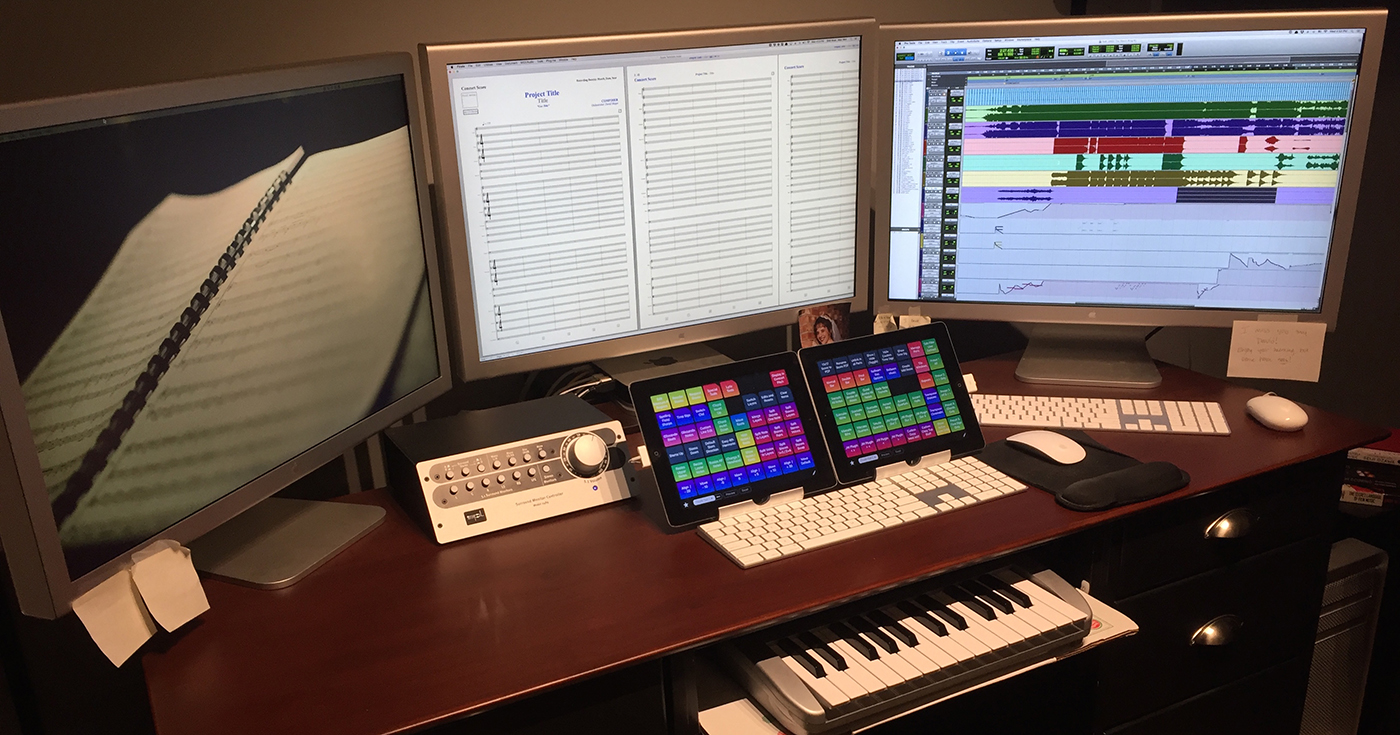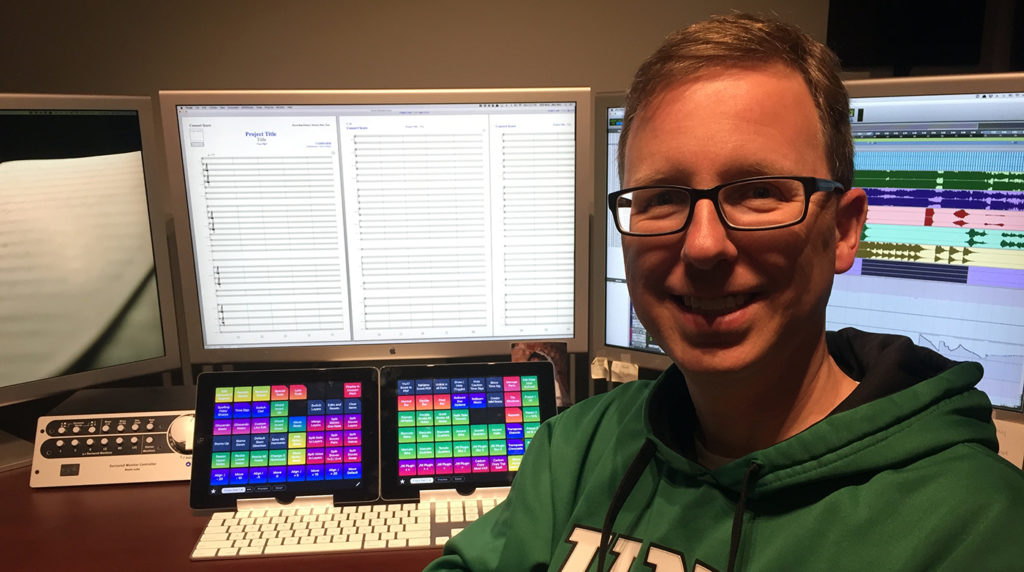
In the first half of our conversation with Nashville-based orchestrator, conductor, and arranger David Shipps, we didn’t talk much about Finale. This time, David shares a few Finale tips. He also reveals some productivity secrets involving the use of the shortcut program Keyboard Maestro and a few iPads (as seen above).
What was your first introduction to Finale?
My first introduction to Finale was as a freshman at the University of North Texas, studying music composition. Before that, I had tinkered around in Encore (I think) and some sequencing program on our family’s Apple computer at home. But until college, I pretty much had always written everything by hand.
Have a favorite Finale story?
Several years back, my young assistant, Rob Adams (who’s now my full-time part prep guy), asked me “Hey, how come this happens when I hold down the option key?” He was referring to copying expressions up and down staves by merely holding down the option key and pressing the up and down arrows. My response? “I have no idea what you’re talking about! But oh my gosh, this is awesome!” So, we kind of stumbled into that Finale improvement, and he’s always thought it was cool that he was the one who showed me a tip in Finale that day.
Can you share another Finale tip with us?
I think my biggest tip would be to learn all the little tips. When I first learned Finale, no one ever showed me how to be fast in Finale, and I’m convinced that I spent years in Finale being slow. Oh to get those years back! So, each day, take a moment to try something new. Memorize the shortcut keys. Discover a plugin that might save you 5-10 seconds. Figure out how to improve your workflow. Because when we’re more efficient in Finale, we have more time available to be creative, and isn’t that what we all want?
Speaking of making good use of shortcuts, could you describe your Finale workspace/studio configuration?
You’ll see in the photo above that I use multiple monitors. Often times, I work with two (or even three) Finale files relating to one score, so having plenty of screen space surely helps. Also, I would be completely useless these days without my shortcut program, Keyboard Maestro. Oh, and my two iPads I use for touchscreens, can’t forget those!
I’ve got a small MIDI keyboard for Speedy Note entry, and a full-size keyboard on my writing desk for when I really have to bang out some ideas! The monitor to the right is connected to a second computer that runs Pro Tools – my DAW of choice when working with files from composers.
What Finale 25 feature or bug fix were you most excited to discover?
Being able to differentiate between showing time signatures on score vs parts. That helps a lot on the scores I work with – we often use large time signatures.
Can you tell us how often you build a new Finale template and what you make sure to include in your template to ensure success?
I typically build a new template every 2-3 years, and honestly, there’s a part of me that enjoys it. When I’m building a template, I am sure to design my expression library to include markings I use regularly, same for the articulation and smart shape libraries. Another thing I like to do is have all of my linked parts already generated and formatted on the page. It helps us in the long run when we’re prepping our parts.

You receive source files from many different composers and arrangers, which gives you a great perspective of what does and doesn’t work well. What advice would you give young composers interested in producing notation for live performance?
First off, if you’re only working with samples, it’s easy to forget what the music might look like on the page. Try to take a moment and consider how it will look as music notation. Is this piece really in a fast four? What about triplets vs being notated in 12/8 time? Our computers can (and will) play anything, but when we’re asking humans to play the music, sometimes we need to stop for a moment and make sure that we’re going to write it in a way that makes the most sense on the page.
Another problem I run into sometimes is when composers forget to pay attention to the ensemble they’re writing for. For example: let’s say we have a brass section with 4 horns, 3 trombones, and a tuba, but my MIDI file has a passage with 12 notes in the brass ensemble patch. Oops… Now, as the orchestrator, remember, it’s my job to make the composer look like a genius, so part of that job means that I need to “have his back” and make sure that this passage sounds full and vibrant even though I don’t have enough folks. That might be an extreme example, but it’s happened before.
On the flip side of that, I notice that sometimes composers will only program for what they hear. What I mean is, I might have a climax in the orchestra with some big chord, and yet only see one note in the trombone or tuba patch, typically the root. Where are all the inner parts? Inner parts are what fill out the orchestra and give it the width and breadth to the sound. Here’s the deal: I’ll admit it, often times in an orchestral recording, you might not specifically hear trombone 2 or 3rd trumpet or the 1st bassoon because he’s doubling the lower clarinet part, but that doesn’t mean they’re not playing those notes!
See what I’m getting at? Lastly, I would say (and this is sort of a global concept) – if you are going to have your music played by a live orchestra, spend time around live players. Remember that it’s easy to make computers play anything we dream up, but that doesn’t mean it will translate well to the live orchestra. Observe, listen intently, and pay attention to things like phrasing, breathing, balance (within sections and between sections of the orchestra), releases, etc…
What rhythms are easy for brass players but maybe are difficult for strings? What volume might be comfortable for woodwinds but sometimes pitchy for the brass? Notice how a passage is overly taxing for the brass or how a particular tempo change might be tricky for the ensemble as a whole. All of these observations will help you write in such a way that the orchestra will play your music naturally and you’ll feel like you’re getting the most energy and emotional impact out of the orchestra.
Thanks again to David for sharing his experience with us. He clearly enjoys sharing his Finale expertise with others; he’s even posted some tips on his blog. Join me in keeping an eye open for David’s name in the credits!